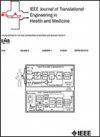Deep Learning-Based Automatic Diagnosis System for Developmental Dysplasia of the Hip
IF 4.4
3区 医学
Q2 ENGINEERING, BIOMEDICAL
IEEE Journal of Translational Engineering in Health and Medicine-Jtehm
Pub Date : 2025-04-15
DOI:10.1109/JTEHM.2025.3560877
引用次数: 0
Abstract
The clinical diagnosis of developmental dysplasia of the hip (DDH) typically involves manually measuring key radiological angles—Center-Edge (CE), Tönnis, and Sharp angles—from pelvic radiographs, a process that is time-consuming and susceptible to variability. This study aims to develop an automated system that integrates these measurements to enhance the accuracy and consistency of DDH diagnosis. We developed an end-to-end deep learning model for keypoint detection that accurately identifies eight anatomical keypoints from pelvic radiographs, enabling the automated calculation of CE, Tönnis, and Sharp angles. To support the diagnostic decision, we introduced a novel data-driven scoring system that combines the information from all three angles into a comprehensive and explainable diagnostic output. The system demonstrated superior consistency in angle measurements compared to a cohort of eight moderately experienced orthopedists. The intraclass correlation coefficients for the CE, Tönnis, and Sharp angles were 0.957 (95% CI: 0.952–0.962), 0.942 (95% CI: 0.937–0.947), and 0.966 (95% CI: 0.964–0.968), respectively. The system achieved a diagnostic F1 score of 0.863 (95% CI: 0.851–0.876), significantly outperforming the orthopedist group (0.777, 95% CI: 0.737–0.817,基于深度学习的髋关节发育不良自动诊断系统
髋关节发育不良(DDH)的临床诊断通常涉及人工测量骨盆x线片的关键放射角度-中心边缘(CE), Tönnis和锐角,这一过程既耗时又容易变化。本研究旨在开发一个集成这些测量的自动化系统,以提高DDH诊断的准确性和一致性。我们开发了一个端到端的深度学习模型,用于关键点检测,该模型可以准确地从骨盆x线片中识别8个解剖关键点,从而实现CE、Tönnis和Sharp角的自动计算。为了支持诊断决策,我们引入了一种新颖的数据驱动评分系统,该系统将所有三个角度的信息结合到一个全面且可解释的诊断输出中。与8位中等经验的骨科医生相比,该系统在角度测量方面表现出优越的一致性。CE、Tönnis和Sharp角的类内相关系数分别为0.957 (95% CI: 0.952-0.962)、0.942 (95% CI: 0.937-0.947)和0.966 (95% CI: 0.964-0.968)。该系统的诊断F1评分为0.863 (95% CI: 0.851-0.876),显著优于骨科组(0.777,95% CI: 0.737-0.817, p = 0.005),并且单独使用每个角度的临床诊断标准(p\lt 0.001)。该系统为DDH提供可靠和一致的放射角度自动测量和可解释的诊断输出,优于中等经验的临床医生。临床影响:这种人工智能解决方案减少了人工测量的可变性和潜在错误,为临床医生提供了更加一致和可解释的DDH诊断工具。
本文章由计算机程序翻译,如有差异,请以英文原文为准。
求助全文
约1分钟内获得全文
求助全文
来源期刊

IEEE Journal of Translational Engineering in Health and Medicine-Jtehm
Engineering-Biomedical Engineering
CiteScore
7.40
自引率
2.90%
发文量
65
审稿时长
27 weeks
期刊介绍:
The IEEE Journal of Translational Engineering in Health and Medicine is an open access product that bridges the engineering and clinical worlds, focusing on detailed descriptions of advanced technical solutions to a clinical need along with clinical results and healthcare relevance. The journal provides a platform for state-of-the-art technology directions in the interdisciplinary field of biomedical engineering, embracing engineering, life sciences and medicine. A unique aspect of the journal is its ability to foster a collaboration between physicians and engineers for presenting broad and compelling real world technological and engineering solutions that can be implemented in the interest of improving quality of patient care and treatment outcomes, thereby reducing costs and improving efficiency. The journal provides an active forum for clinical research and relevant state-of the-art technology for members of all the IEEE societies that have an interest in biomedical engineering as well as reaching out directly to physicians and the medical community through the American Medical Association (AMA) and other clinical societies. The scope of the journal includes, but is not limited, to topics on: Medical devices, healthcare delivery systems, global healthcare initiatives, and ICT based services; Technological relevance to healthcare cost reduction; Technology affecting healthcare management, decision-making, and policy; Advanced technical work that is applied to solving specific clinical needs.
 求助内容:
求助内容: 应助结果提醒方式:
应助结果提醒方式:


